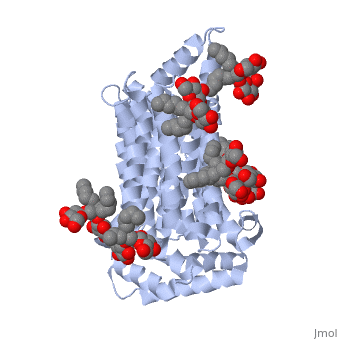Sandbox Reserved 1320
From Proteopedia
(Difference between revisions)
| Line 11: | Line 11: | ||
There are two chains that compose the GLUT3 protein. These chains are named the <scene name='77/777640/A_chain/3'>A chain</scene> and the <scene name='77/777640/B_chain/2'>B Chain</scene>. | There are two chains that compose the GLUT3 protein. These chains are named the <scene name='77/777640/A_chain/3'>A chain</scene> and the <scene name='77/777640/B_chain/2'>B Chain</scene>. | ||
== Disease == | == Disease == | ||
| - | + | Deficiency of GLUT3 protein is associated with the severity of Alzheimer's disease (AD) and expression of AD symptoms. <ref>doi: 10.1016/j.jalz.2017.09.011</ref> | |
== Relevance == | == Relevance == | ||
The GLUT3 protein has been found to be the only glucose transport protein that works in bovine (cow) and humans lenses. Glucose transport into eye lenses is important because the metabolism of glucose is necessary to create energy to maintain the transparency of lenses <ref>doi: 10.1016/j.exer.2017.06.012</ref> | The GLUT3 protein has been found to be the only glucose transport protein that works in bovine (cow) and humans lenses. Glucose transport into eye lenses is important because the metabolism of glucose is necessary to create energy to maintain the transparency of lenses <ref>doi: 10.1016/j.exer.2017.06.012</ref> | ||
Revision as of 21:23, 20 February 2018
GLUT3
| |||||||||||
References
- ↑ An Y, Varma VR, Varma S, Casanova R, Dammer E, Pletnikova O, Chia CW, Egan JM, Ferrucci L, Troncoso J, Levey AI, Lah J, Seyfried NT, Legido-Quigley C, O'Brien R, Thambisetty M. Evidence for brain glucose dysregulation in Alzheimer's disease. Alzheimers Dement. 2017 Oct 19. pii: S1552-5260(17)33765-2. doi:, 10.1016/j.jalz.2017.09.011. PMID:29055815 doi:http://dx.doi.org/10.1016/j.jalz.2017.09.011
- ↑ Lim JC, Perwick RD, Li B, Donaldson PJ. Comparison of the expression and spatial localization of glucose transporters in the rat, bovine and human lens. Exp Eye Res. 2017 Aug;161:193-204. doi: 10.1016/j.exer.2017.06.012. Epub 2017 Jun, 15. PMID:28625822 doi:http://dx.doi.org/10.1016/j.exer.2017.06.012

